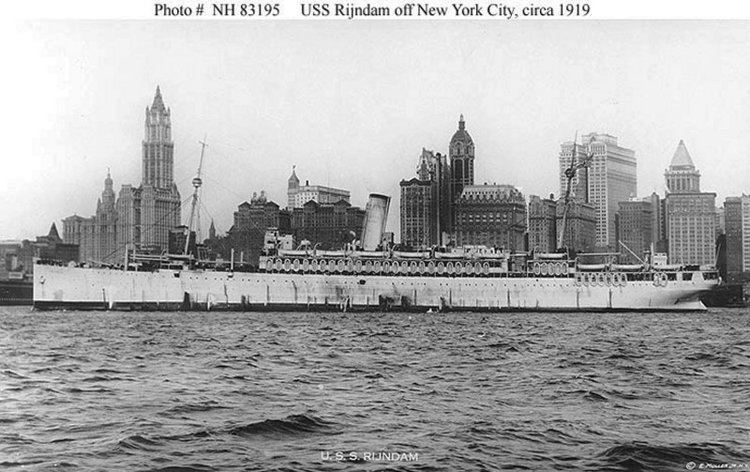Name USS Rijndam (ID-2505) Completed 3 October 1901 Commissioned 1 May 1918 Launched 1901 Weight 24,030 tons Builder Harland and Wolff | Yard number 336 Acquired March 1918 Decommissioned 22 October 1919 Length 171 m Displacement 21.45 million kg | |
 | ||
Metro simulator beta 3 10 rijndam metro line m4 airport central station airport
USS Rijndam (ID-2505) was a transport for the United States Navy during World War I. Both before and after her Navy service she was known as SS Rijndam or Ryndam as an ocean liner for the Holland America Line.
Contents
History
Rijndam was launched during 1901 by Harland & Wolff Ltd. of Belfast, Ireland, as a steel passenger liner for the Holland America Line.
On 25 May 1915, Rijndam was rammed by the Norwegian-flagged fruit steamer Joseph J. Cuneo about 10 nautical miles (19 km) south of the Nantucket Shoals. Responding to the SOS, U.S. Navy battleships Texas, South Carolina, Louisiana, and Michigan, rescued 230 passengers from the damaged liner.
On 18 January 1916, Rijndam suffered damage when she struck a mine in the Thames Estuary during World War I.
Interned at New York later in World War I, she was seized during March 1918 by United States Customs officials along with 88 other Dutch vessels, 31 of which entered U.S. Navy service. Rijndam was commissioned 1 May 1918 at New York for service as a troopship, with Commander John J. Hannigan in command.
Rijndam departed New York 10 May 1918 on the first of six convoy voyages to Europe before the war's end, accompanied by President Lincoln, Covington, British troopship Dwinsk, and Italian steamers Caserta and Dante Alighieri. The group rendezvoused with a similar group that left Newport News, Virginia, the same day, consisting of American transports Lenape, Pastores, Wilhelmina, Princess Matoika, Antigone, and Susquehanna, the British troopship Kursk, and the Italian Duca d'Aosta. American cruiser Frederick served as escort for the assembled ships, which were the 35th U.S. convoy of the war. On 20 May, the convoy sighted and fired on a "submarine" that turned out to be a bucket; the next day escort Frederick left the convoy after being relieved by 11 destroyers. Three days later the convoy sighted land at 06:30 and anchored at Brest that afternoon.
On her return journey on 31 May 1918, Rijndam was nearly torpedoed in the same attack by German submarine U-90 that resulted in the loss of President Lincoln. Rijndam was able to avoid the torpedoes and, shortly afterward, nearly rammed a submarine cruising at periscope depth.
On her next transport voyage, Rijndam left New York on 15 June with Kroonland, Finland, DeKalb, George Washington, Covington, Italian steamer Dante Alighieri, and British steamer Vauban and met up with the Newport News portion of the convoy—which included Lenape, Wilhelmina, Princess Matoika, Pastores, and British troopship Czar—the next morning and set out for France. The convoy was escorted by cruisers North Carolina and Frederick, and destroyers Stevens and Fairfax; battleship Texas and several other destroyers joined in escort duties for the group for a time. The convoy had a false alarm when a floating barrel was mistaken for submarine, but otherwise uneventfully arrived at Brest on the afternoon of 27 June.
Rijndam landed troops and supplies at Brest, France, on three more occasions through November 1918, and called once at Saint-Nazaire during July. Rijndam made seven round-trip voyages from Quiberon, Saint-Nazaire, and Brest, France, following the end of World War I, returning U.S. troops and personnel to Newport News, Virginia; Norfolk, Virginia; Hoboken, New Jersey; and New York.
In March 1919, Rijndam and Princess Matoika raced each other from Saint-Nazaire to Newport News in a friendly competition that received national press coverage in the United States. Rijndam, the slower ship, was just able to edge out the Matoika—and cut two days from her previous fastest crossing time—by appealing to the honor of the soldiers of the 133rd Field Artillery returning home aboard her and employing them as extra stokers for her boilers.
She carried over 3,000 passengers on many of her 26 trips across the Atlantic, completing her active service upon arrival at New York 4 August 1919 from Brest. Transferred from the Cruiser and Transport Force on 11 August 1919 to the custody of the 3rd Naval District, Rijndam was decommissioned and returned to her former owner on 22 October 1919 at New York. Rijndam resumed her mercantile career under the Dutch flag, remaining active until scrapped during 1929.
